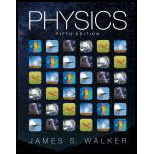
Concept explainers
Resolving Lines on an HDTV
The American Television Systems Committee (ATSC) sets the standards for high-definition television (HDTV). One of the approved HDTV formats is 1080p, which means 1080 horizontal lies scanned progressively (p)—that is, one line after another in sequence from top to bottom. Another standard is 1080, which stands for 1080 lines interfaced (i). In this system it takes two scans of the screen to show a complete picture the first scan shows the “even” horizontal lines, the second scan shows the “odd” horizontal lines. Interlacing was the norm for television displays until the 1970s, and is still used in most standard-definition TVs today. Progressive scanning became more popular with the advent of computer monitors, and is used today in LCD, DIP, and plasma HDTVs.
In addicting, the ATSC sets the standard for the shape of displays. For example it defines a “wide screen” to be one with a 16:9 ratio; that is, the width of the display is greater than the height by the factor 16/9. The ratio is just a little larger than the golden ratio,
For the following problems assume that 1080 horizontal lines are displayed on a television with a screen that is 15 7 inches high (32-inch diagonal), and that the light coming from the screen has a wavelength of 645 nm Also, assume that the pupil of your eye has a diameter of 5.50 mm. and that the index of refraction 01 the interior of the eye is 1.36.
• According to the Rayleigh criterion, what is the closest you can be to the TV screen before resolving the individual Horizontal Ines? (In practice you can to ccosOerably closer than this distance before resolving the lines.)
- A. 3.51 ft
- B. 4.53 ft
- C. 11.5 ft
- D. 14.0 ft
Want to see the full answer?
Check out a sample textbook solution
Chapter 28 Solutions
Physics (5th Edition)
Additional Science Textbook Solutions
Chemistry: An Introduction to General, Organic, and Biological Chemistry (13th Edition)
Cosmic Perspective Fundamentals
Campbell Essential Biology with Physiology (5th Edition)
Campbell Essential Biology (7th Edition)
Campbell Biology (11th Edition)
Physics for Scientists and Engineers: A Strategic Approach, Vol. 1 (Chs 1-21) (4th Edition)
- Mick and Rick are twins born on Earth in the year 2175. Rick grows up to be an Earth-bound robotics technician while Mick becomes an intergalactic astronaut. Mick leaves the Earth on his first space mission in the year 2200 and travels, according to his clock, for 10 years at a speed of 0.75c. Unfortunately, at this point in his journey, the structure of his ship undergoes mechanical breakdown and the ship explodes. How old is Rick when his brother dies?arrow_forwardHi, I have canceled, why did you charge me again?arrow_forwardNo chatgpt pls will upvotearrow_forward
 Physics for Scientists and Engineers, Technology ...PhysicsISBN:9781305116399Author:Raymond A. Serway, John W. JewettPublisher:Cengage Learning
Physics for Scientists and Engineers, Technology ...PhysicsISBN:9781305116399Author:Raymond A. Serway, John W. JewettPublisher:Cengage Learning University Physics Volume 3PhysicsISBN:9781938168185Author:William Moebs, Jeff SannyPublisher:OpenStax
University Physics Volume 3PhysicsISBN:9781938168185Author:William Moebs, Jeff SannyPublisher:OpenStax College PhysicsPhysicsISBN:9781285737027Author:Raymond A. Serway, Chris VuillePublisher:Cengage Learning
College PhysicsPhysicsISBN:9781285737027Author:Raymond A. Serway, Chris VuillePublisher:Cengage Learning College PhysicsPhysicsISBN:9781938168000Author:Paul Peter Urone, Roger HinrichsPublisher:OpenStax College
College PhysicsPhysicsISBN:9781938168000Author:Paul Peter Urone, Roger HinrichsPublisher:OpenStax College Physics for Scientists and Engineers: Foundations...PhysicsISBN:9781133939146Author:Katz, Debora M.Publisher:Cengage Learning
Physics for Scientists and Engineers: Foundations...PhysicsISBN:9781133939146Author:Katz, Debora M.Publisher:Cengage Learning College PhysicsPhysicsISBN:9781305952300Author:Raymond A. Serway, Chris VuillePublisher:Cengage Learning
College PhysicsPhysicsISBN:9781305952300Author:Raymond A. Serway, Chris VuillePublisher:Cengage Learning





